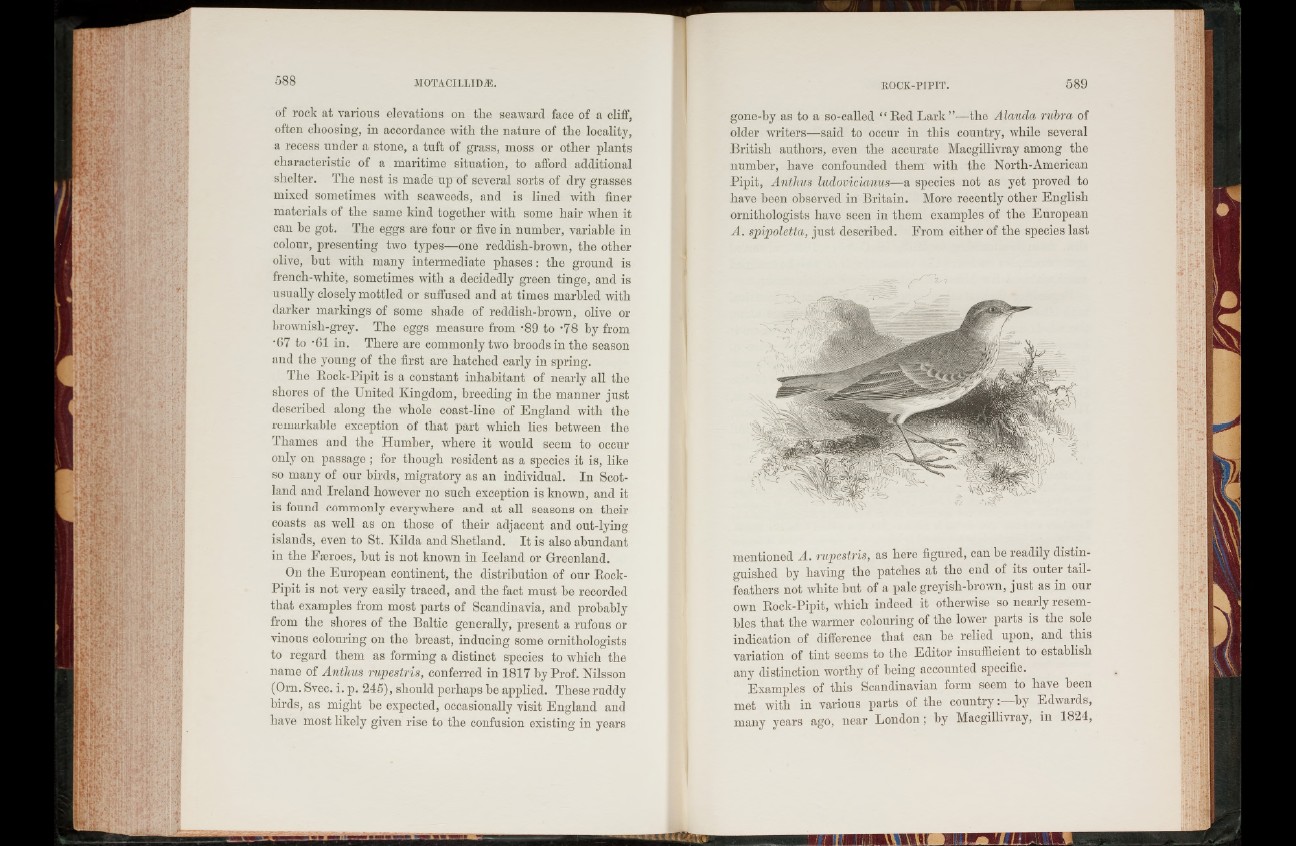
of rock at various elevations on the seaward face of a cliff,
often choosing, in accordance with the nature of the locality,
a recess under a stone, a tuft of grass, moss or other plants
characteristic of a maritime situation, to afford additional
shelter. The nest is made up of several sorts of dry grasses
mixed sometimes with seaweeds, and is lined with finer
materials of the same kind together with some hair when it
can be got. The eggs are four or five in number, variable in
colour, presenting two types—one reddish-brown, the other
olive, but with many intermediate phases: the ground is
french-white, sometimes with a decidedly green tinge, and is
usually closely mottled or suffused and at times marbled with
darker markings of some shade of reddish-brown, olive or
brownish-grey. The eggs measure from '89 to '78 by from
•67 to ’61 in. There are commonly two broods in the season
and the young of the first are hatched early in spring.
The Rock-Pipit is a constant inhabitant of nearly all the
shores of the United Kingdom, breeding in the manner just
described along the whole coast-line of England with the
remarkable exception of that part which lies between the
Thames and the Humber, where it would seem to occur
only on passage ; for though resident as a species it is, like
so many of our birds, migratory as an individual. In Scotland
and Ireland however no such exception is known, and it
is found commonly everywhere and at all seasons on their
coasts as well as on those of their adjacent and out-lying
islands, even to St. Kilda and Shetland. I t is also abundant
in the Faroes, but is not known in Iceland or Greenland.
On the European continent, the distribution of our Rock-
Pipit is not very easily traced, and the fact must be recorded
that examples from most parts of Scandinavia, and probably
from the shores of the Baltic generally, present a rufous or
vinous colouring on the breast, inducing some ornithologists
to regard them as forming a distinct species to which the
name of Antlius rupestris, conferred in 1817 by Prof. Nilsson
(Orn. Svec. i. p. 245), should perhaps be applied. These ruddy
birds, as might be expected, occasionally visit England and
have most likely given rise to the confusion existing in years
----------
gone-by as to a so-called “ Red L a rk ”—the Alauda rubra of
older writers—said to occur in this country, while several
British authors, even the accurate Macgillivray among the
number, have confounded them with the North-American
Pipit, Antlius ludovicianus—a species not as yet proved to
have been observed in Britain. More recently other English
ornithologists have seen in them examples of the European
A. spipoletta, just described. From either of the species last
mentioned A. rupestris, as here figured, can be readily distinguished
by having the patches at the end of its outer tail-
feathers not white but of a pale greyish-brown, just as in our
own Rock-Pipit, which indeed it otherwise so nearly resembles
that the warmer colouring of the lower parts is the sole
indication of difference that can be relied upon, and this
variation of tint seems to the Editor insufficient to establish
any distinction worthy of being accounted specific.
Examples of this Scandinavian form seem to have been
met with in various parts of the c o u n t r y b y Edwards,
many years ago, near London; by Macgillivray, in 1824,